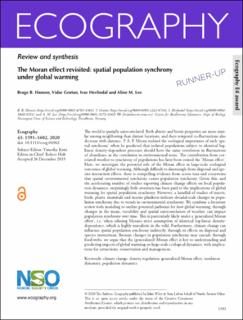| dc.description.abstract | The world is spatially autocorrelated. Both abiotic and biotic properties are more similar among neighboring than distant locations, and their temporal co-fluctuations also decrease with distance. P. A. P. Moran realized the ecological importance of such ‘spatial synchrony’ when he predicted that isolated populations subject to identical log-linear density-dependent processes should have the same correlation in fluctuations of abundance as the correlation in environmental noise. The contribution from correlated weather to synchrony of populations has later been coined the ‘Moran effect’. Here, we investigate the potential role of the Moran effect in large-scale ecological outcomes of global warming. Although difficult to disentangle from dispersal and species interaction effects, there is compelling evidence from across taxa and ecosystems that spatial environmental synchrony causes population synchrony. Given this, and the accelerating number of studies reporting climate change effects on local population dynamics, surprisingly little attention has been paid to the implications of global warming for spatial population synchrony. However, a handful of studies of insects, birds, plants, mammals and marine plankton indicate decadal-scale changes in population synchrony due to trends in environmental synchrony. We combine a literature review with modeling to outline potential pathways for how global warming, through changes in the mean, variability and spatial autocorrelation of weather, can impact population synchrony over time. This is particularly likely under a ‘generalized Moran effect’, i.e. when relaxing Moran's strict assumption of identical log-linear density-dependence, which is highly unrealistic in the wild. Furthermore, climate change can influence spatial population synchrony indirectly, through its effects on dispersal and species interactions. Because changes in population synchrony may cascade through food-webs, we argue that the (generalized) Moran effect is key to understanding and predicting impacts of global warming on large-scale ecological dynamics, with implications for extinctions, conservation and management. | en_US |

